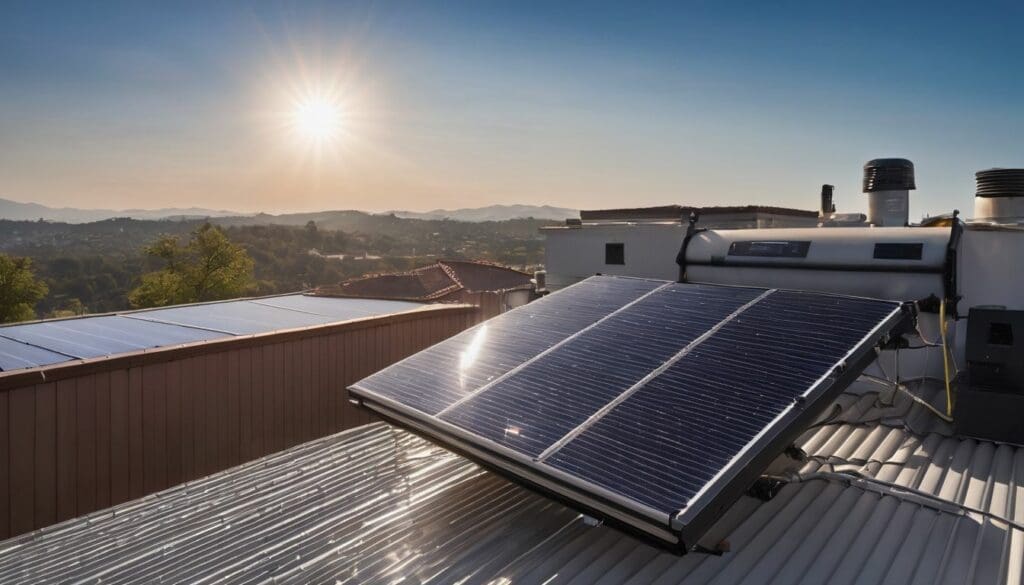Rising energy bills are putting a strain on households everywhere. By harnessing the sun’s power, solar water heating systems offer an economical solution to this challenge. This article will guide you through the basics of solar water heating, from understanding its principles to installing it in your own home.
Discover a brighter, greener future with just a scroll!
Key Takeaways
- Solar water heating systems use sunlight to produce hot water, which can lead to significant savings on energy bills and reduce reliance on non-renewable resources.
- There are different types of solar heating systems available, such as passive and active systems, each suited for various climates and needs.
- Installing a solar water heater involves assessing roof strength, positioning collectors for maximum sun exposure, connecting to an existing water heater, insulating pipes properly, and ensuring safety measures are in place.
- These environmentally friendly systems not only help in cutting down carbon emissions but also encourage sustainable living by increasing energy independence from fossil fuels.
- While the initial setup cost might be higher compared to traditional heaters, the long – term benefits include lower utility costs with potential government incentives making it more economical over time.
What is Solar Water Heating?
Solar water heating harnesses the power of the sun to heat water for household use. There are different types of solar water heating systems that work by collecting and converting sunlight into thermal energy for heating water.
Overview of how it works
Harnessing the sun’s power, solar water heating systems capture and convert sunlight into heat. They typically consist of solar collectors mounted on a roof or open area with ample sunshine.
These collectors absorb the sun’s rays and warm up a heat transfer fluid flowing through them. The heated fluid then travels to a storage tank where it warms water for domestic use.
In homes and businesses alike, this renewable energy method provides hot water throughout the year. During times when sunlight is limited, some systems are equipped with a conventional backup heater to ensure an uninterrupted supply of hot water.
This combination offers a sustainable solution that conserves energy, reduces utility bills, and supports environmental conservation efforts by tapping into clean energy sources.
Types of solar water heating systems
Solar water heating systems come in different types. They include:
- Passive Solar Water Heating Systems: These systems do not require pumps or any moving parts to function. They use natural convection and gravity to circulate the water.
- Active Solar Water Heating Systems: These systems use pumps to circulate water through the collector and into the storage tank. There are two types of active systems – direct circulation and indirect circulation.
- Direct Circulation Systems: In this type, water flows through the collectors and into the home, with no heat exchanger involved. They work well in climates where freezing is rare.
- Indirect Circulation Systems: In this type, a heat-transfer fluid passes through the collectors and a heat exchanger, transferring its heat to the water in the storage tank. This system can be used in colder climates as it is more resistant to freezing.
Fundamentals of Solar Water Heating
Understanding solar energy and the principles behind solar water heating is essential for making informed decisions about this sustainable technology. From the equipment and materials used to how solar hot water systems work, these fundamentals lay the groundwork for successful installation and operation.
Understanding solar energy
Solar energy is harnessed from the sun to produce heat and electricity. Solar panels, known as photovoltaic panels, capture the sunlight and convert it into electrical power through the photovoltaic effect.
This sustainable technology provides an alternative energy source that contributes to reducing carbon footprint and increasing energy independence.
Solar water heating systems use solar thermal collectors to absorb sunlight and generate heat. These systems are a space-efficient way of utilising solar energy for water and space heating needs.
Equipment and materials used
Solar water heating systems require a few essential components to harness the power of the sun effectively. The following are the key equipment and materials used:
- Solar Collector: This is the heart of the system, absorbing sunlight and converting it into heat energy to warm the water.
- Heat Exchanger: It transfers the heat from the solar collector to the water being stored or circulated.
- Water Storage Tank: This tank stores the heated water for later use, ensuring hot water availability even during cloudy days.
- Circulation Pump: It helps in circulating water between the solar collector and storage tank, ensuring efficiency.
- Control System: This regulates the temperature and flow of water through the system, maintaining optimal performance.
Installation of Solar Water Heating Systems
Before installing a solar water heating system, it’s important to consider the design and planning aspects. Following the necessary steps for installation is crucial in ensuring efficient and effective functioning of the system.
Planning and design considerations
When planning and designing solar water heating systems, it is essential to evaluate the available space for installation and assess the orientation of the location to maximise sun exposure.
The positioning of the solar collector should be carefully considered to ensure optimal performance. Additionally, factors such as local weather patterns, shading from nearby buildings or trees, and structural support for the system need to be taken into account during the design process.
Furthermore, selecting high-quality materials and components that are compatible with the specific solar water heating system is crucial for longevity and efficiency. Proper insulation, piping layout, and accessibility for maintenance should also be part of the overall planning and design considerations to enhance functionality and ease of use.
Steps for installation
Solar water heating systems are installed on the roof or in an open area, facing the sun. This enables the solar panels to capture sunlight efficiently. Here are the steps involved in installing a solar water heating system:
- Roof Assessment: Firstly, conduct a thorough assessment of your roof to determine its suitability for holding the weight of the solar water heating system.
- Positioning and Mounting: Carefully position and secure the mounting brackets for the solar panels on a sturdy part of the roof or an open area with unobstructed sunlight.
- Connection to Water Heater: Connect the solar collector to your existing water heater using appropriate piping and fittings.
- Installation of Storage Tank: Install a well-insulated storage tank suitable for holding heated water from the solar system.
- Insulation: Properly insulate all pipes and components to prevent heat loss and ensure maximum energy efficiency.
- Wiring and Controls: Connect wiring to link the system to a control panel, ensuring that it is safely grounded and wired according to local regulations.
- Testing and Calibration: Thoroughly test and calibrate the system after installation, confirming that all components are functioning optimally.
- Safety Measures: Implement safety measures such as pressure relief valves and temperature sensors to ensure safe operation of the system.
- Commissioning: Finally, commission your newly installed solar water heating system, ready for sustainable, cost-effective hot water production.
Benefits of Solar Water Heating
Solar water heating systems offer a cost-effective and eco-friendly alternative to traditional water heating methods. By reducing the carbon footprint and increasing energy independence, these systems contribute to sustainable living.
Cost-effectiveness
Solar water heating systems offer significant cost-effectiveness over time. By harnessing the power of sunlight to heat water, these systems can lead to substantial long-term savings on energy bills.
The initial investment in a solar water heating system may be higher than traditional alternatives, but the reduced reliance on non-renewable energy sources translates into lower utility costs and a smaller environmental impact.
This economic benefit is particularly appealing for environmentally conscious individuals who prioritise sustainability in their lifestyle choices. Additionally, with various government incentives and rebates available for solar energy systems, the overall cost-effectiveness is further enhanced.
Embracing solar water heating not only provides financial advantages but also contributes positively towards reducing carbon emissions and preserving our planet’s natural resources.
Reducing carbon footprint
Reducing carbon footprint is a significant benefit of solar water heating systems. By harnessing the power of the sun to heat water, these systems reduce the reliance on traditional energy sources that emit carbon dioxide and other greenhouse gases.
As a result, using solar water heaters helps in decreasing the overall carbon emissions associated with heating water for domestic or commercial purposes.
Furthermore, integrating solar hot water heating into everyday life promotes sustainable living while contributing to environmental conservation efforts. This reduces dependence on non-renewable energy sources, aligning with eco-friendly initiatives and supporting a greener future.
Increased energy independence
Solar water heating systems contribute to increased energy independence by harnessing the power of the sun to heat water for residential or commercial use. By relying on solar energy, users reduce their reliance on traditional energy sources, leading to a decreased demand for non-renewable resources.
This shift towards renewable energy not only reduces carbon emissions but also helps individuals and communities become less vulnerable to fluctuations in fossil fuel prices. Embracing solar water heating promotes self-sufficiency and resilience while supporting sustainable practices in line with environmental conservation efforts.
Conclusion
In conclusion, solar water heating systems offer a sustainable solution for environmentally conscious individuals. They harness the power of the sun to provide cost-effective and energy-efficient hot water.
The installation of these systems requires careful planning and design considerations but offers long-term benefits such as reduced carbon footprint and increased energy independence.
Embracing green technology like solar water heating can contribute positively towards environmental conservation while also offering economic advantages.
FAQs
1. What are solar water heating systems?
Solar water heating systems use solar energy to heat water for your home, saving you money and conserving energy.
2. How do solar heating systems work?
Solar heating installation captures sunlight using panels on your roof, which heats the water stored in a special tank by following solar heater working principles.
3. Are solar water heaters a form of green technology?
Yes, they are an eco-friendly solution that taps into renewable solar power to reduce reliance on non-renewable resources and help with energy economics.
4. Can I install a solar water heating system in my house?
If your home gets enough sunlight, you can have a professional set up a solar heating system based on fundamental principles to provide hot water efficiently.





